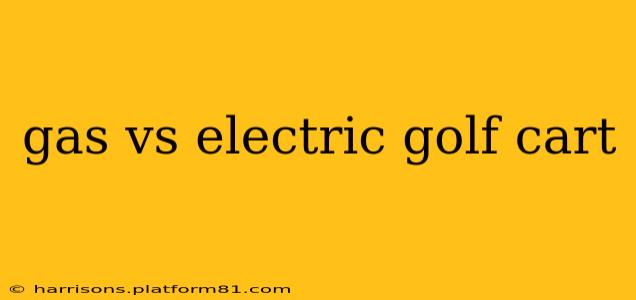Choosing between a gas and electric golf cart is a significant decision, impacting your budget, maintenance needs, and overall golfing experience. This comprehensive guide will delve into the key differences between these two power sources, helping you make the informed choice that best suits your needs and lifestyle.
What are the Pros and Cons of Gas Golf Carts?
Gas-powered golf carts offer a potent blend of power and range, making them ideal for larger courses or those with hilly terrain. However, they come with their own set of drawbacks.
Pros:
- Greater Power and Torque: Gas engines provide significantly more power, especially uphill, making them a better choice for challenging courses.
- Longer Range: A single tank of gas allows for extended use without needing to recharge. This is particularly beneficial for longer rounds or those who use their cart for purposes beyond golf.
- Faster Top Speeds: Gas carts generally reach higher top speeds than electric models.
Cons:
- Higher Maintenance: Gas engines require regular maintenance, including oil changes, tune-ups, and potential repairs, leading to higher ongoing costs.
- Emissions: Gas carts produce emissions, contributing to air pollution.
- Noisier Operation: Gas engines are noticeably louder than electric motors, potentially disturbing other golfers or the environment.
- More Expensive Initial Purchase: Typically, gas golf carts have a higher initial purchase price compared to their electric counterparts.
What are the Pros and Cons of Electric Golf Carts?
Electric golf carts are becoming increasingly popular due to their ease of use, environmental friendliness, and lower running costs. However, there are some limitations to consider.
Pros:
- Lower Running Costs: Electricity is generally cheaper than gasoline, resulting in lower fuel costs. Maintenance is also typically less expensive.
- Quieter Operation: Electric motors are significantly quieter than gas engines, providing a more peaceful golfing experience.
- Environmentally Friendly: Electric carts produce zero tailpipe emissions, making them a more sustainable choice.
- Easier to Maintain: Electric carts require less frequent maintenance compared to gas-powered models.
Cons:
- Limited Range: Electric carts have a shorter range on a single charge, requiring regular recharging.
- Less Powerful: Electric motors generally provide less power and torque, making them less suitable for hilly courses.
- Slower Top Speeds: Electric carts typically have lower top speeds compared to gas-powered models.
- Charging Time: Recharging an electric cart can take several hours, depending on the battery type and charger.
What is the best type of golf cart battery?
The type of battery significantly impacts the performance and longevity of your electric golf cart. Common types include lead-acid, AGM (Absorbent Glass Mat), and lithium-ion. Lithium-ion batteries are becoming increasingly popular due to their longer lifespan, faster charging times, and lighter weight, although they typically come with a higher initial cost. Lead-acid batteries are more affordable but offer shorter lifespan and require more maintenance. AGM batteries represent a middle ground, offering a balance of performance, cost, and maintenance. The best battery for you will depend on your budget, usage patterns, and desired performance.
How long do golf cart batteries last?
The lifespan of a golf cart battery varies significantly depending on the type of battery, usage patterns, and maintenance. Lead-acid batteries typically last 2-5 years, while AGM batteries can last 3-7 years, and lithium-ion batteries can last 5-10 years or even longer. Proper maintenance, such as regular charging and avoiding deep discharges, can significantly extend the lifespan of any type of golf cart battery.
Which type of golf cart is better for hilly terrain?
Gas golf carts are generally better suited for hilly terrain due to their superior power and torque. Electric carts may struggle on steep inclines, especially when carrying passengers or additional weight. However, some high-performance electric carts with powerful motors can handle moderate hills effectively. Consider the steepness of the hills on your course when making your decision.
How much does it cost to maintain a gas golf cart vs an electric golf cart?
Gas golf carts generally have higher maintenance costs due to the need for regular oil changes, tune-ups, and potential engine repairs. Electric carts require less frequent maintenance, primarily focusing on battery care and occasional component checks. However, replacing a battery for an electric cart can be a significant expense. The overall maintenance cost depends on various factors such as usage frequency and the age of the cart.
In conclusion, the best golf cart for you depends on your individual needs and priorities. Consider the terrain, your budget, and your environmental concerns to make an informed decision. Weighing the pros and cons outlined above will help you determine whether a gas or electric golf cart is the right choice for your golfing adventures.
